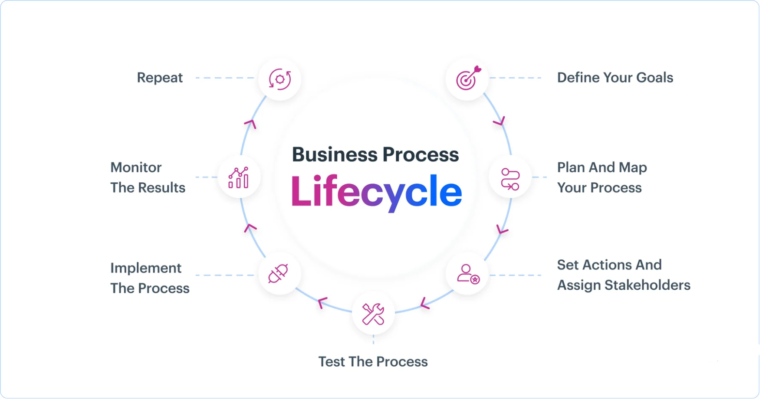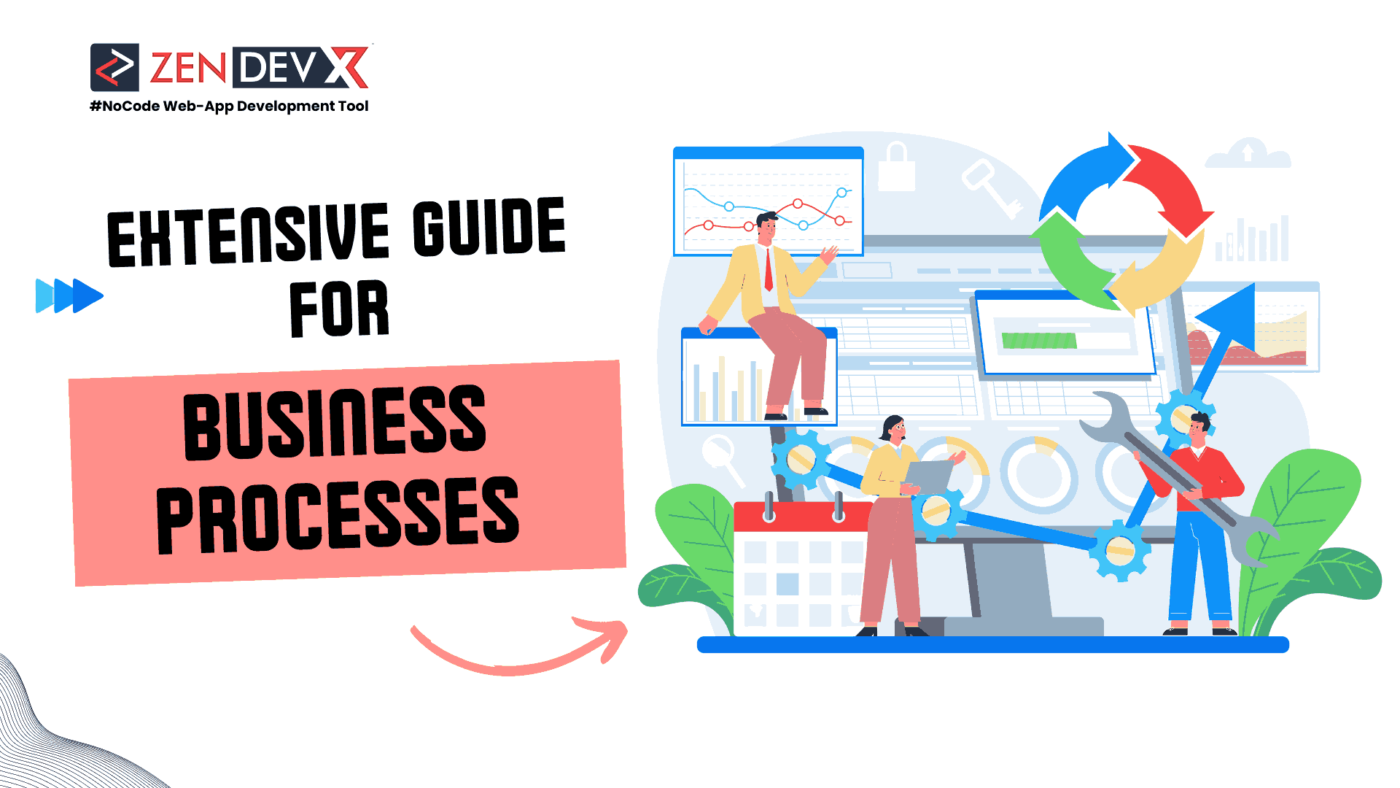The symbiotic relationship between technology leadership and process optimization is ready to change how companies run as we welcome the opportunities and challenges 2024 presents. Designed as a strategic toolset to enable Business Technology Partners and IT leaders in negotiating the complexities of modern workplaces, this extensive guide includes As we enter 2024 and beyond, this book will be a lighthouse of information helping them to coordinate simplified procedures, thereby promoting a culture of efficiency, creativity, and excellence as they negotiate issues including legacy systems and agile development.
Though everyone talks about business processes, there is still great ambiguity about them. Here is all the information you will need to help you to be clear about what they are and why your company should know about them.
A Business Process is:
A business process is a sequence of actions or collection of activities carried out by a group of stakeholders aiming at an organizational goal. People or systems execute the procedures methodically in order to reach a pre-defined goal. Effective and simplified business process execution immediately helps corporate operations and expansion to be successful. Simply said, a business process is a sequence of operations and tasks carried out once finished that will achieve an organizational purpose. Every stage of a business process represents an activity allocated to a participant. It is the basic building block for a number of connected concepts such as process automation, corporate process management, etc.
Various Forms of Company Processes
Operational Processes
Operational processes—also referred to as core business processes—are those directly beneficial to the consumers and the company itself. Their main contribution is income making. Product manufacture, the order-to-cash system, and product distribution to consumers are few instances of operational procedures.
Supporting Systems
These systems help and enable the fundamental procedures to be carried out without problems. While they may not directly generate income, they help internal departments create a cooperative environment where the main operations may be in line to improve performance. As they enable a company to grow, human resources, finance management, administration, and operations fit under supporting processes.
Methods of Management
From beginning to end, these systems plan, monitor, manage, and control the core and accompanying processes. These procedures guarantee that company activities are smoothly and effectively carried out since they have goals. Their priorities are internal and outside business functionality monitoring, opportunity and challenge analysis, and guarantee of ongoing process improvement everywhere.
Technology for Business Process Management
Business process technology is the application of systems and software-based automation, streamlining, optimization of business processes. By means of manual work completion, it saves time and money, helps companies increase efficiency, lower mistakes, and improve effectiveness. It can be utilized in many other sectors and tailored as needed. Among the business process technologies are ERP systems, customer relationship management (CRM) tools, and workflow management tools.
The Value of Corporate Procedures
In big companies, the requirement of a business process and its benefits are rather clear. Any company’s lifeline is its process, which also allows it to simplify daily operations so that resources are used as best they may be.
The Significance of Business Processes
Main justifications for clearly specified business procedures:
- List the chores that directly relate to your more general corporate objectives.
- Increase process effectiveness.
- Simplify departmental, person-based, functional communication.
- Approvals guarantee responsibility and best use of available resources.
- Stop anarchy from invading your daily activities.
- Standardize a set of processes to finish jobs truly important for your company.
Example from a Business Procedure
Let us take the hiring procedure of an HR department as an instance. From advertising the job position to integrating the worker, the process consists of several stages. While every company is unique, a basic procedure can look like this:
- The HR executive updates the job posting.
- Several applicants use a portal.
- The HR executive reviews the applicants and sorts the best fit ones.
- The chosen applicants are invited for the upcoming recruiting phases.
- At the last phase of hiring, the suitable candidate is selected.
- Negotiations on policies and pay follow.
- The candidate takes the offer letter and a protracted employee onboarding process then follows.
The Seven Business Process Lifecycle Steps

- Specify Your Objectives: For what use is the process meant? Why was it invented? How will you find out whether it works?
- Plan and Map Your Procedure: How can one reach the objectives using the strategies? This is the overall road plan for the procedure.
- Decide on Actions and Allocate Participants: Determine the specific jobs your machinery and staff need to complete to carry out the strategy.
- Examine the Method: Run the process on a little scale to observe its results. Note any holes and correct them.
- Start the Procedure: Start running the process in a live environment. Share correctly and equip every involved party.
- Keep an Eye on the Outcomes: Go over the procedure and examine its trends. Note the process history.
- Reiterate: Should the process meet the objectives assigned to it, copy it for further projects. Simplify and standardize your company’s procedures.
How Can You Evaluate Your Company Process’s Performance?
Use these steps to evaluate the success of business processes:
- List Key Performance Indicators (KPIs): Choose which measures most apply to your company’s operations—time-based, financial, quality-based, or productivity-based.
- Data Gathering: Apply tools and programs designed to compile KPIs-related data.
- Examine the Gathered Data: Use data analytics to examine trends, patterns, and anomalies. Identify successful and unsuccessful aspects.
- Improve Yourself: Use your study to identify areas where the process might be strengthened.
- Watch Constantly: Maintain constant process monitoring through ongoing data collection and analysis.
Advantages of Applying Business Process Software
Specifically made to increase the effectiveness of processes across sectors and businesses, benefits of adopting business process software include:
- Reduction of Hazards: By helping to avoid and resolve mistakes and bottlenecks, BPM systems help to lower risks.
- Eliminating Repetitions: Monitoring systems let one find and eliminate repeated chores. Using BPM systems also improves resource allocation so that human effort is directed just on pertinent tasks.
- Lowered Expenses: Enhanced process visibility enables zero-in-on waste of money. Costs are thus kept down and savings are raised.
- Better Teamwork: BPM software’s transparency helps buyers, external vendors, and internal teams all work together better.
- Velocity: Improved procedures allow for more organizational operations’ agility.
- Higher Output: Ship-shaped processes speed approvals, simplify information retrieval, and help to ensure accuracy.
- Improved Effectiveness: BPM systems’ comprehensive dashboards offer a bird’s-eye perspective of process performance.
- More Compliance: Creating audit trails and following industry rules and standards is simpler and more thorough with BPM systems.
What Are the Main Characteristics of a Perfect Company Process?
Four basic qualities define a perfect corporate process:
- Finite: A strong business process clearly specifies both the beginning and the end.
- Consistent: One can run a good business process an endless number of times.
- Generates Value: It seeks to translate the generation of value into executable tasks.
- Adaptability: It is naturally flexible and easy to modify when improvements are found.
Business Process Related Terminologies
1. Computerized Business Processes
A technology-driven approach to automatically run a business process in order to achieve it with minimal cost and in a shorter period. Benefits include:
- Increasing effectiveness
- Reducing human error
- Adapting to changing corporate needs
- Clarifying employment roles and obligations
2. Management of Business Processes
A methodical way to make the processes of a company more dynamic and efficient, BPM is a continual method to always improve corporate processes. There are several on-site and cloud-based tools accessible to apply BPM.
3. Modelling Business Processes
A diagrammatic or a structural representation of the flow of corporate activities or functions within an organization. It helps in recording and baselining the present activity flow for improvements.
4. Improvement of Business Processes
A strategic planning endeavor to make business processes more efficient and help general corporate growth by means of change.
5. Business Process Development and Management (BPDM)
Planning, developing, and executing new or modified business processes efficiently and effectively in line with the general strategy of the company.
6. Re-engineering Corporate Processes
A complete overhaul of company processes to deliver significant impact by determining inefficiencies, eliminating non-value tasks, and applying a top-to-bottom modification.
7. Business Process Optimization
Using analytics and business process mining technologies to remove inefficiencies and bottlenecks from an existing process.
8. Map Business Processes
Breaking down process sequences into logical sections while documenting and clarifying them with flow charts or written documentation.
9. Business Process Analysis
Determining which solutions best address company issues by means of identifying business needs.
10. Integration of Business Procedures
Providing a process model defining the sequence, hierarchy, events, execution logic, and transfer of information amongst systems housed in the same company.
11. Model of Business Processes
A technique for analyzing business processes to assess performance, test process design, identify bottlenecks, and find how a process runs in many environmental situations with varied datasets.
12. Change in Business Processes
Drastically altering a set of processes required to satisfy a certain company goal, ensuring alignment of technology, policies, objectives, and staff.
13. Business Flow in Processes
A form or flow chart mirroring the process you are developing, consisting of stages and steps to finish.
14. Business Process Observation
Active observation of operations and activities to provide management with understanding of significant transactions and business processes inside a company.
15. Business Rules Engines (BREs)
Ensuring that decision-making processes always conform with corporate policy, guaranteeing consistency.
16. Variations Between Method and Process
A process is a high-level overview of activities required to achieve a result. A method provides specific directions on how to complete the project.
Time to Design Your Business Processes
Designed business procedures help your teams travel the road to success. Everyone works with a clear vision toward the final objective and well-defined roles and duties. The circumstances whereby businesses pay costly consultants to create business procedures are becoming rare. Being the expert who understands the nuances of your company, you do not want another individual to design a business process for you.


